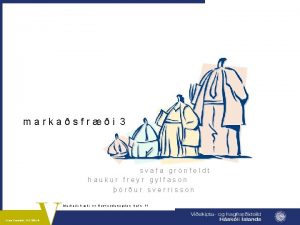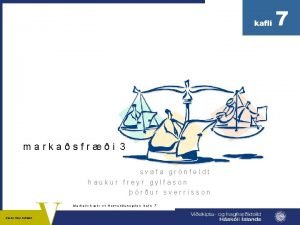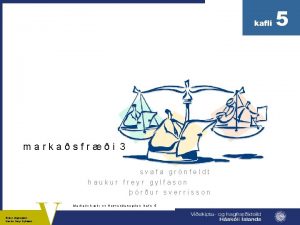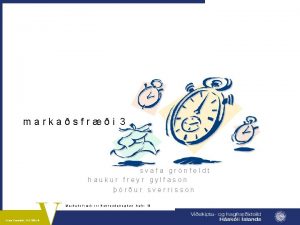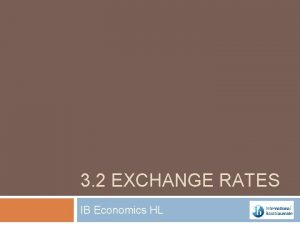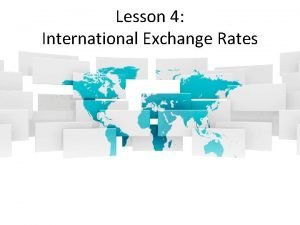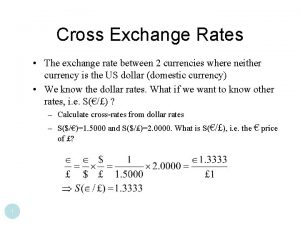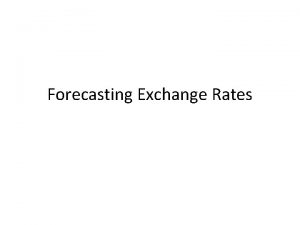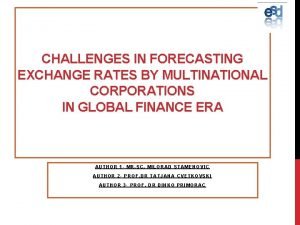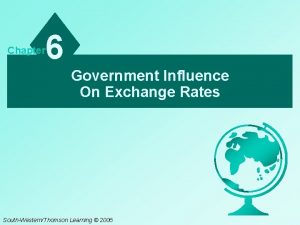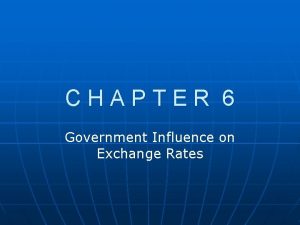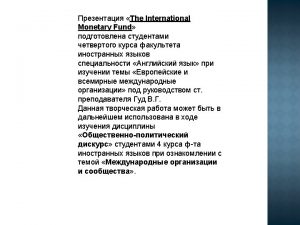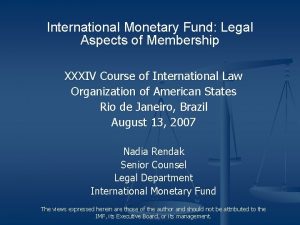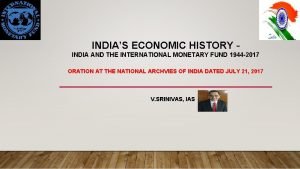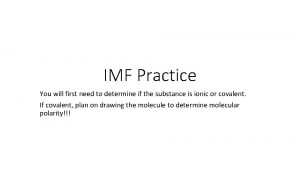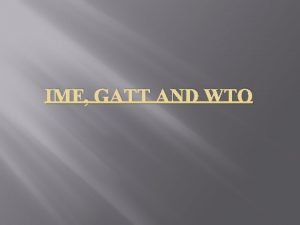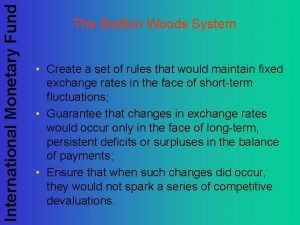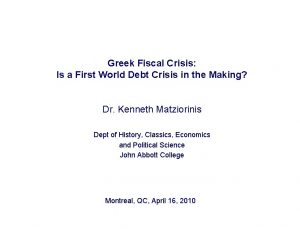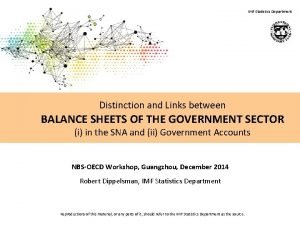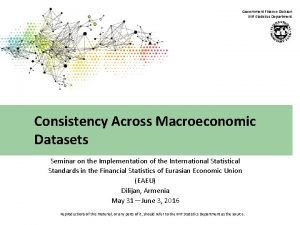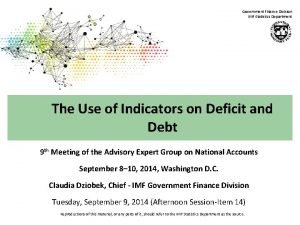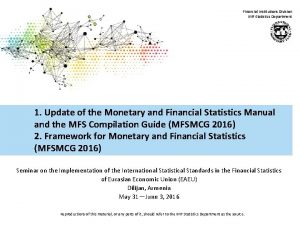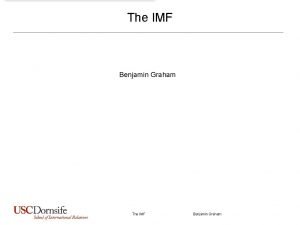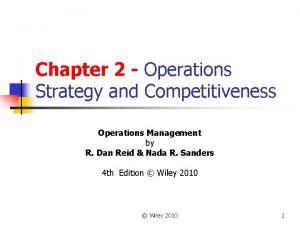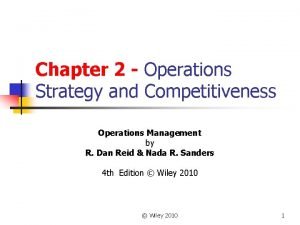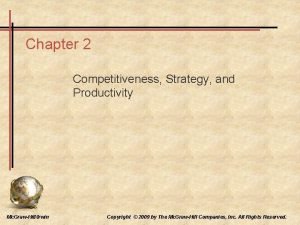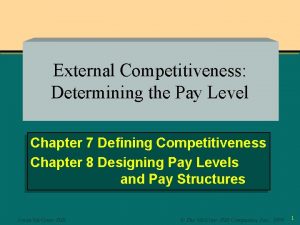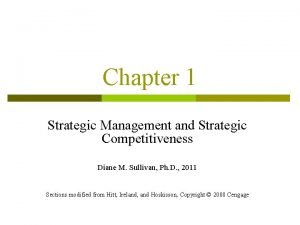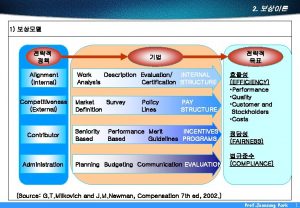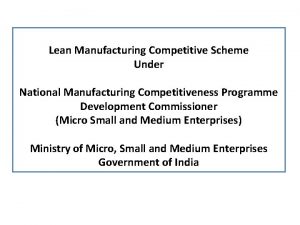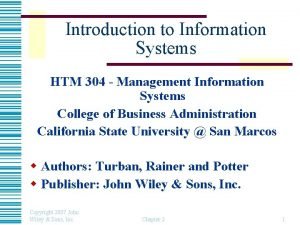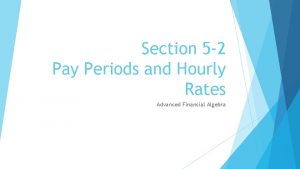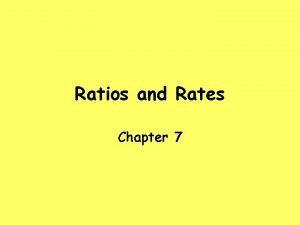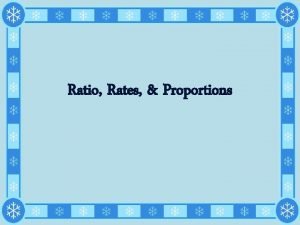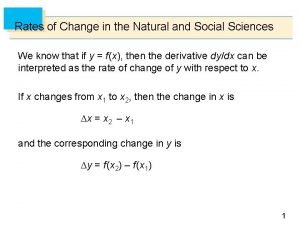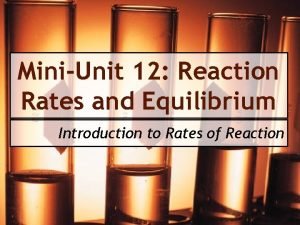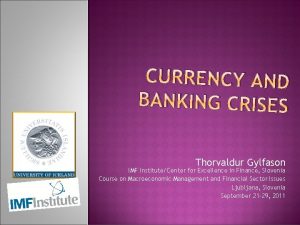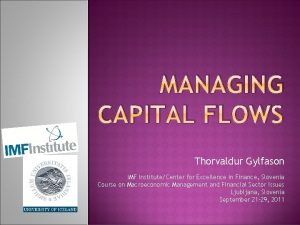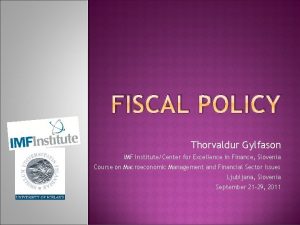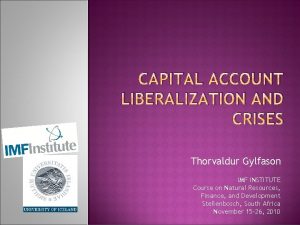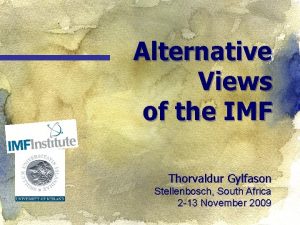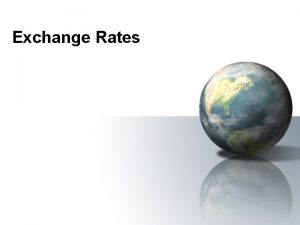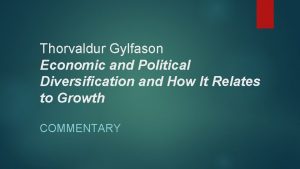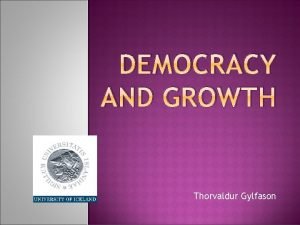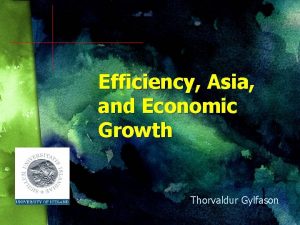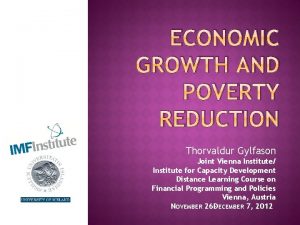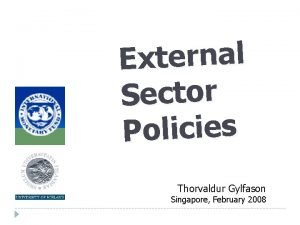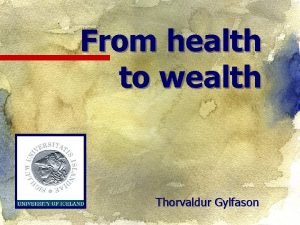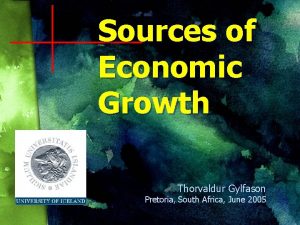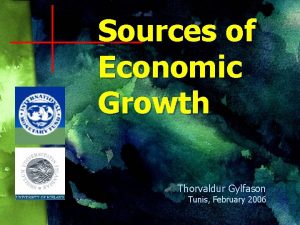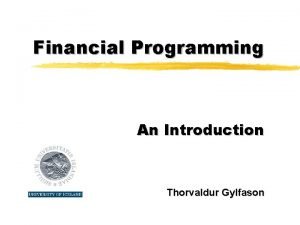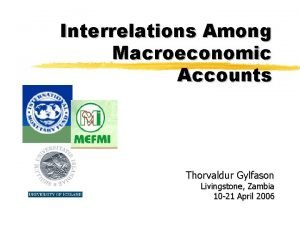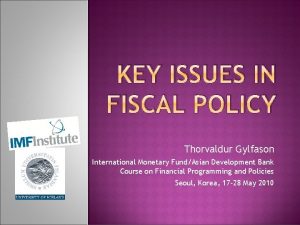EXCHANGE RATES AND COMPETITIVENESS Thorvaldur Gylfason IMF InstituteCenter













































































- Slides: 77

EXCHANGE RATES AND COMPETITIVENESS Thorvaldur Gylfason IMF Institute/Center for Excellence in Finance, Slovenia Course on Macroeconomic Management and Financial Sector Issues Ljubljana, Slovenia September 21– 29, 2011

OUTLINE IN FIVE PARTS 1. Real exchange rates versus nominal exchange rates 2. Exchange rate policy and welfare 3. Capital flows 4. Exchange rate regimes ü To float or not to float 5. Why we have fewer currencies than countries

1 REAL VS. NOMINAL EXCHANGE RATES Increase in Q means real appreciation Q = real exchange rate e = nominal exchange rate P = price level at home P* = price level abroad e refers to foreign currency content of domestic currency

REAL VS. NOMINAL EXCHANGE RATES Devaluation or e depreciation of makes Q also P s s e l n u e t a i c e r p de ve rises so as to lea Q unchanged Q = real exchange rate e = nominal exchange rate P = price level at home P* = price level abroad

THREE THOUGHT EXPERIMENTS 1. Suppose e falls Then more rubles per dollar, so X rises, rises Z falls 2. Suppose P falls Then X rises, rises Z falls 3. Suppose P* rises Then X rises, rises Z falls Capture all three by supposing Q falls Then X rises, rises Z falls

THE IMPORTANCE OF APPROPRIATE SIDE MEASURES Remember: Devaluation needs to be accompanied by fiscal and monetary restraint to prevent prices from rising and thus eating up the benefits of devaluation To work, nominal devaluation must result in real devaluation

Real exchange rate 2 EXCHANGE RATE POLICY AND WELFARE yments for imports of Pa s, and e ic v r e s , s d o go capital Imports Equilibrium ts of r o p x e m ro Earnings f , and s e c i v r e s goods, capital Exports Foreign exchange

EXCHANGE RATE POLICY AND WELFARE Equilibrium between demand supply in foreign exchange market establishes üEquilibrium real exchange rate üEquilibrium in balance of payments BOP = X + Fx – Z – Fz =X–Z+F = current account + capital account = 0 ccount a t n e r r u c = Z – X ccount a l ia c n a in f d n a F = capital

EXCHANGE RATE POLICY R moves when AND WELFARE R Real exchange rate e is fixed Deficit Imports Overvaluation Exports Foreign exchange

Price of foreign exchange EXCHANGE RATE POLICY AND WELFARE Overvaluation works like a price ceiling Supply (exports) Overvaluation Deficit Demand (imports) Foreign exchange

MARKET EQUILIBRIUM AND WELFARE DR = 0, so R is fixed Price A B C Consumer surplus E Producer surplus when e floats Supply Total welfare gain associated with market equilibrium equals producer surplus (= ABE) plus consumer surplus (= BCE) Demand Quantity

MARKET INTERVENTION AND WELFARE Price A J Welfare loss F B H C E G Consumer surplus = AFGH Producer surplus = CGH Total surplus = AFGC Supply Price ceiling imposes a welfare loss equivalent to the triangle EFG Price ceiling Demand Quantity

MARKET INTERVENTION les g n a i r t AND WELFARE e Welfar ngles a ri t r e g r e Harb Price A J Welfare loss F B H C Price ceiling imposes a welfare loss that results from shortage (e. g. , deficit) E G Shortage Supply K Price ceiling Demand Quantity

APPLICATION 1: DUTCH DISEASE Appreciation of currency in real terms, either through inflation or nominal appreciation, leads to a loss of export competitiveness In 1960 s, Netherlands discovered natural resources (gas deposits) Currency appreciated Exports of manufactures and services suffered, but not for long Not unlike natural resource discoveries, aid inflows could trigger the Dutch disease in New Palgrave in ” e s a e receiving countries is D h tc See my “Du s Online ic m o n o c E f o y r a Diction

Real exchange rate DUTCH DISEASE: HOW OIL EXPORTS CROWD OUT NONOIL EXPORTS C B A Oil discovery leads to appreciation, and reduces nonoil exports Imports Exports with oil Exports without oil Foreign exchange Composition of exports matters

DUTCH DISEASE: HOW FOREIGN AID CAN CROWD OUT EXPORTS rade vs. aid Real exchange rate T C B A Foreign aid leads to appreciation, and reduces exports (e. g. , Zambia) Imports Exports with aid Exports without aid Foreign exchange

APPLICATION 2: OVERVALUATION Governments may try to keep the national currency overvalued üTo keep foreign exchange cheap üTo have power to ration scarce foreign exchange üTo make GNP look larger than it is Other examples of price ceilings üNegative real interest rates üRent controls in cities

INFLATION AND OVERVALUATION Inflation can result in an overvaluation of the national currency üRemember: Q = e. P/P* Suppose e adjusts to P with a lag Then Q is directly proportional to inflation Numerical example

INFLATION AND OVERVALUATION Real exchange rate Suppose inflation is 10 percent per year 110 105 100 Average Time

INFLATION AND OVERVALUATION Real exchange rate Suppose inflation rises to 20 percent per year d Hence, increase real inflation lifts the s long a e t a r e g n a h c x e as the nominal exchange rate g adjusts with a la 120 110 Average 100 Time

HOW TO CORRECT OVERVALUATION Under floating Depreciation is automatic: e moves But depreciation may take time Under a fixed exchange rate regime Devaluation will lower e and thereby also Q – provided inflation is kept under control Does devaluation improve the current account? The Marshall-Lerner condition

MARSHALL-LERNER CONDITION: THEORY B = e. X – Z = e. X(e) – Z(e) Valuation effect arises from the ability to affect foreign prices Lower e raises X Z Lower e reduces ed, Suppose prices are fix so that e = Q Not clear that a lower e helps B because decrease in e lowers e. X if X stays put Let’s do the arithmetic Bottom line is: Devaluation strengthens current account as long as s a = elasticity of export s b = elasticity of import

MARSHALL-LERNER CONDITION -a Export elasticity 1 Lower e raises X Z Lower e reduces - + Import b elasticity 1

MARSHALL-LERNER CONDITION b -a X y Assume X = Z/e initiall if unt o c c a t n e r r u c s n ake Appreciation we

MARSHALL-LERNER CONDITION: EVIDENCE Econometric studies indicate that the Marshall-Lerner condition is almost invariably satisfied Industrial countries: a = 1, b = 1 Developing countries: a = 1, b = 1. 5 Hence, s n e h t g n e r t s n io t a lu a v De the current account

EVIDENCE FROM DEVELOPING COUNTRIES Argentina Brazil India Kenya Korea Morocco Pakistan Philippines Turkey Average Elasticity of exports 0. 6 0. 4 0. 5 1. 0 2. 5 0. 7 1. 8 0. 9 1. 4 1. 1 Elasticity of imports 0. 9 1. 7 2. 2 0. 8 1. 0 0. 8 2. 7 1. 5

THE SMALL COUNTRY CASE Small countries are price takers abroad ü Devaluation has no effect on the foreign currency price of exports and imports So, the valuation effect does not arise Devaluation will, at worst, if exports and imports are insensitive to exchange rates (a = b = 0), leave the current account unchanged Hence, if a > 0 or b > 0, devaluation strengthens the current account

RECENT IMF STUDY (2006) For an emerging country with … üInitial trade balance üExport-to-GDP ratio of 40% … nominal depreciation by 10% permanently improves trade balance by 1½% to 2% of GDP in medium term üEffect depends on class of exporter üOil, non-oil, manufactures üMost of the effect is through imports and is felt within 3 to 5 years

3 CAPITAL FLOWS Capital mobility A stylized view of capital mobility 1860 -2000 First era of international financial integration Return toward financial integration Capital controls Source: Obstfeld & Taylor (2002), “Globalization and Capital Markets, ” NBER WP 8846.

CONCEPTUAL FRAMEWORK Real interest rate Emerging countries save a little Saving Investment Loanable funds

CONCEPTUAL FRAMEWORK Real interest rate Industrial countries save a lot Saving Investment Loanable funds

CONCEPTUAL FRAMEWORK Emerging countries Industrial countries Saving Borrowing Investment Loanable funds Real interest rate Financial globalization encourages investment in emerging countries and saving in industrial countries Lending Saving Investment Loanable funds

EMERGING MARKETS: NET PRIVATE CAPITAL FLOWS, 1980 -2009 Source: IMF WEO

PUSH VS. PULL FACTORS External factors “pushed” capital from industrial countries to LDCs Cyclical conditions in industrial countries Recessions in the early 1990 s Decline in world interest rates Structural changes in industrial countries Financial structure developments Demographic changes

PUSH VS. PULL FACTORS Internal factors “pulled” capital into LDCs from industrial countries Macroeconomic fundamentals Reduction in barriers to capital flows Private risk-return characteristics Creditworthiness Productivity

POTENTIAL BENEFITS OF CAPITAL FLOWS Improved allocation of global savings Allows capital to seek highest returns Greater efficiency of investment More rapid economic growth Reduced macroeconomic volatility through risk diversification (which dampens business cycles) Income smoothing Consumption smoothing

POTENTIAL RISKS OF CAPITAL FLOWS Open capital accounts may make receiving countries vulnerable to foreign shocks Magnify domestic shocks and lead to contagion Limit effectiveness of domestic macro policy instruments Countries with open capital accounts are vulnerable to Shifts in market sentiment Reversals of capital inflows May lead to macroeconomic crisis Sudden reserve loss, exchange rate pressure Excessive BOP and macro adjustment Financial crisis

POTENTIAL RISKS OF CAPITAL FLOWS Overheating of the economy Excessive expansion of aggregate demand with inflationary pressures, real exchange rate appreciation, widening current account deficit Increase in consumption and investment relative to GDP Quality of investment suffers Construction booms Monetary consequences of capital inflows and accumulation of foreign exchange reserves depend crucially on exchange regime

Real stock prices during inflow periods, selected countries Chile 1978 -81 Mexico Venezuela Sweden Chile 1989 -94 Finland Year with respect to start of Inflow period Note: The Index for Finland, Mexico, and Sweden is shown on the left; the index for Chile during the 1980 s and 1990 s and for Venezuela is shown on the right. Source: World Bank (1997)

STOCK PRICES IN THAILAND 1987 -2000

EARLY WARNING SIGNS Large deficits Current account deficits Government budget deficits Poor bank regulation Government guarantees (implicit or explicit), moral hazard Stock and composition of foreign debt Ratio of short-term liabilities to foreign reserves Mismatches Maturity mismatches (borrowing short, lending long) Currency mismatches (borrowing in foreign currency, lending in domestic currency)

ASIA: RATIO OF SHORT-TERM LIABILITIES TO FOREIGN RESERVES IN 1997

LARGE REVERSALS

COUNTRY EXPERIENCES WITH CAPITAL ACCOUNT LIBERALIZATION External or financial crisis followed capital account liberalization § E. g. , Mexico, Sweden, Turkey, Korea, Paraguay Response § Rekindled support for capital controls § Focus on sequencing of reforms Sequencing makes a difference § Strengthen financial sector and prudential framework before removing capital account restrictions § Remove restrictions on FDI inflows early § Liberalize outflows after macroeconomic imbalances have been addressed

SOME TYPES OF CAPITAL FLOWS ARE RISKIER THAN OTHERS High degree of risk sharing Portfolio equity Foreign direct investment Short term debt Long term debt (bonds) No risk sharing Transitory Permanent

SEQUENCING CAPITAL ACCOUNT LIBERALIZATION Pre-conditions for liberalization Sound macroeconomic policies Strong domestic financial system Strong and autonomous central bank Timely, accurate, and comprehensive data disclosure

4 EXCHANGE RATE REGIMES The real exchange rate always floats üThrough nominal exchange rate adjustment or price change Even so, it matters how countries set their nominal exchange rates because floating takes time There is a wide spectrum of options, from absolutely fixed to completely flexible exchange rates

EXCHANGE RATE REGIMES There is a range of options Monetary union or dollarization üMeans giving up your national currency or sharing it with others (e. g. , EMU, CFA, EAC) Currency board üLegal commitment to exchange domestic foreign currency at a fixed rate Fixed exchange rate (peg) Crawling peg Managed floating Pure floating

EXCHANGE RATE REGIMES Fixed Currency Union/ Dollarization Currency Board Flexible Peg • Fixed • Horizontal Bands Crawling Peg • Without Bands Floating • Managed • Independent • With Bands No Independent Monetary Policy

EXCHANGE RATE REGIMES Currency union or dollarization Currency board Peg FIXED Fixed Horizontal bands Crawling peg Without bands With bands Floating FLEXIBLE Managed Independent

BASICALLY FIXED Dollarization Use another country’s currency as sole legal tender Currency union Share same currency with other union members Currency board Legally commit to exchange domestic currency for specified foreign currency at fixed rate Conventional (fixed) peg Single currency peg Currency basket peg

INTERMEDIATE Flexible peg Fixed but readily adjusted Crawling peg Complete §Compensate for past inflation §Allow for future inflation Partial §Aimed at reducing inflation, but real appreciation results because of the lagged adjustment Fixed but adjustable

BASICALLY FLOATING Managed floating Management by sterilized intervention I. e. , by buying and selling foreign exchange Management by interest rate policy, i. e. , monetary policy E. g. , by using high interest rates to attract capital inflows and thus lift the exchange rate of the currency Pure floating

FLOATING REGIMES “Pure” float X - Z + F = ΔR = 0, so X – Z = -F Independent float Exchange rate is market-determined Market intervention is limited to moderating the rate of change and preventing undue fluctuations Managed float Central bank influences exchange rate by active intervention without specifying, or committing to, an exchange rate path

IMPOSSIBLE TRINITY FREE CAPITAL MOVEMENTS ly n o e s o o h Free to c ns; o i t p o e e r two of th of e n o e c i f i must sacr the three 2 Monetary Union (EU) 1 FIXED EXCHANGE RATE 3 MONETARY INDEPENDENCE

IMPOSSIBLE TRINITY FREE CAPITAL MOVEMENTS ly n o e s o o h Free to c ns; o i t p o e e r two of th of e n o e c i f i must sacr the three 2 1 FIXED EXCHANGE RATE 3 Capital controls (China) MONETARY INDEPENDENCE

IMPOSSIBLE TRINITY FREE CAPITAL MOVEMENTS ly n o e s o o h Free to c ns; o i t p o e e r two of th of e n o e c i f i must sacr the three 2 Flexible exchange rate (US, UK, Japan) 1 FIXED EXCHANGE RATE 3 MONETARY INDEPENDENCE

IMPOSSIBLE TRINITY FREE CAPITAL MOVEMENTS ly n o e s o o h Free to c ns; o i t p o e e r two of th of e n o e c i f i must sacr the three 2 Flexible exchange rate (US, UK, Japan) Monetary Union (EU) 1 FIXED EXCHANGE RATE 3 Capital controls (China) MONETARY INDEPENDENCE

KEY POINTS Monetary authorities face a tradeoff between the degree of exchange rate stability and the extent to which they can act to stabilize economic activity and the domestic price level International capital mobility exacerbates the tradeoff

INDUSTRIAL COUNTRY CHOICES TODAY Outside Europe Floating exchange rates Monetary policy used to pursue domestic stabilization objectives Removal of capital controls Within much of Europe Fixed exchange rates Common currency floating against outside world Monetary policies highly coordinated and pooled in the European Central Bank Removal of capital controls

FIX OR FLEX? If capital controls are ruled out in view of the proven benefits of free trade in goods, services, labor, and also capital (four freedoms), freedoms … … then long-run choice boils down to one between monetary independence (i. e. , flexible exchange rates) vs. fixed rates Cannot have both! Either type of regime has advantages as well as disadvantages Let’s quickly review main benefits and costs

BENEFITS AND COSTS Benefits Fixed exchange rates Floating exchange rates Costs

BENEFITS AND COSTS Benefits Fixed exchange rates Floating exchange rates Stability of trade and investment Low inflation Costs

BENEFITS AND COSTS Fixed exchange rates Floating exchange rates Benefits Costs Stability of trade and investment Low inflation Inefficiency BOP deficits Sacrifice of monetary independence

BENEFITS AND COSTS Benefits Costs Fixed exchange rates Stability of trade and investment Low inflation Inefficiency BOP deficits Sacrifice of monetary independence Floating exchange rates Efficiency BOP equilibrium

BENEFITS AND COSTS Benefits Fixed exchange rates Floating exchange rates Stability of trade and investment Low inflation Costs Inefficiency BOP deficits Sacrifice of monetary independence Efficiency Instability of BOP equilibrium trade and investment Inflation

BENEFITS AND COSTS To eliminate high inflation, need fixed me exchange rate for a ti In view of benefits and costs, no single exchange rate regime is right for all countries at all times The regime of choice depends on time and circumstance § If inefficiency and slow growth due to currency overvaluation are the main problem, floating rates can help § If high inflation is the main problem, fixed exchange rates can help, at the risk of renewed overvaluation § Ones both problems are under control, time may be ripe for monetary union What do countries do?

What countries actually do (Number of countries, April 2008) (22) (84) (12) (44) (40) (76) (10) (66) (3) (5) (2) Source: Annual Report on Exchange Arrangements and Exchange Restrictions database. 68

WHAT COUNTRIES ACTUALLY DO (2008, 182 COUNTRIES) No national currency Currency board Conventional fixed rates Intermediate pegs Managed floating Pure floating 6% 7% 36% 5% 24% 22% 100% 54% 46% There is a gradual tendency towards floating, from 10% of LDCs in 1975 to almost 50% today, followed by increased interest in fixed rates through economic and monetary unions

WHY WE HAVE FEWER CURRENCIES THAN COUNTRIES In view of the success of the EU and the euro, economic and monetary unions appeal to many other countries with increasing force Consider four categories Existing monetary unions De facto monetary unions Planned monetary unions Previous – failed! – monetary unions 5

EXISTING MONETARY UNIONS CFA franc 14 CFP franc 3 Pacific island states East Caribbean dollar 8 African countries Caribbean island states Picture of Sir W. Arthur Lewis, the great Nobel-prize winning development economist, adorns the $100 note Euro, more recent 16 EU countries plus 6 or 7 others Thus far, clearly, a major success in view of old conflicts among European nation states, cultural variety, many different languages, etc.

DE FACTO MONETARY UNIONS Australian dollar Australia Indian rupee India plus Bhutan (plus Nepal) New Zealand dollar New plus 3 Pacific island states Zealand plus 4 Pacific island states South African rand South Africa plus Lesotho, Namibia, Swaziland – and now Zimbabwe Swiss franc Switzerland plus Liechtenstein US dollar US plus Ecuador, El Salvador, Panama, and 6 others

PLANNED MONETARY UNIONS East African shilling (2009, delayed) Burundi, Kenya, Rwanda, Tanzania, and Uganda Eco (2009, delayed) Gambia, Ghana, Guinea, Nigeria, and Sierra Leone (plus, perhaps, Liberia) Khaleeji (2010, delayed) Bahrain, Kuwait, Qatar, Saudi-Arabia, and United Arab Emirates Other, more distant plans Caribbean, Southern Africa, South Asia, South America, Eastern and Southern Africa, Africa

PREVIOUS MONETARY UNIONS 99. 95% Danish krone 1886 -1939 Denmark and Iceland 1886 -1939: 1 IKR = 1 DKR 2009: 2, 500 IKR = 1 DKR (due to inflation in Iceland) Scandinavian monetary union 1873 -1914 Denmark, East African shilling 1921 -69 Kenya, Tanzania, Uganda, and 3 others Mauritius rupee Mauritius and Seychelles 1870 -1914 Southern African rand South Norway, and Sweden Africa and Botswana 1966 -76 Many others nt a c i f i n g i s No ces i r p f o e c divergen es t a r y c n e r or cur ion t a r a p e s following

CONFLICTING FORCES Centripetal tendency to join monetary unions, thus reducing number of currencies To benefit from stable exchange rates at the expense of monetary independence Centrifugal tendency to leave monetary unions, thus increasing number of currencies To benefit from monetary independence often, but not always, at the expense of exchange rate stability With globalization, centripetal tendencies appear stronger than centrifugal ones

BOTTOM LINE External sector policies are important because external trade is important for growth Need to maintain real exchange rates at levels that are consistent with BOP equilibrium, including sustainable debt üMust avoid overvaluation! Need to adopt monetary and exchange rate regimes that are conducive to moderate inflation and rapid growth

These slides will be posted on my website: www. hi. is/~gylfason d n E e h T Monetary policy and exchange rate regimes have changed over time Over the past decade, BOTTOM LINE Many countries have moved to more flexible exchange rate arrangements, with more independent monetary policy Others aim to form monetary unions Choice of exchange rate regime may be viewed as a means to sound fiscal, monetary, and financial policies
 A rate is a ratio that compares
A rate is a ratio that compares Ratios rates and unit rates guided notes
Ratios rates and unit rates guided notes Ratios rates and unit rates
Ratios rates and unit rates Ratios rates and unit rates
Ratios rates and unit rates Haukur freyr gylfason
Haukur freyr gylfason Haukur freyr gylfason
Haukur freyr gylfason Haukur freyr gylfason
Haukur freyr gylfason Haukur freyr gylfason
Haukur freyr gylfason Haukur freyr gylfason
Haukur freyr gylfason Exchange rates maths lit grade 12
Exchange rates maths lit grade 12 Foreign exchange worksheet
Foreign exchange worksheet Overvalued currency
Overvalued currency Exchange rates lesson
Exchange rates lesson Cross rate
Cross rate Fundamental forecasting of exchange rates
Fundamental forecasting of exchange rates Challenges in forecasting exchange rates
Challenges in forecasting exchange rates Market-based forecasting of exchange rates
Market-based forecasting of exchange rates Exchange rate forecasting techniques
Exchange rate forecasting techniques Government influence on exchange rates
Government influence on exchange rates Graphing exchange rates
Graphing exchange rates Government intervention in exchange rates
Government intervention in exchange rates Difference between imf and world bank
Difference between imf and world bank Roles of imf
Roles of imf Imf adalah
Imf adalah Imf chem
Imf chem Materi tentang lembaga keuangan internasional
Materi tentang lembaga keuangan internasional Imf functions
Imf functions India imf loan history
India imf loan history Imf practice
Imf practice Objectives of imf
Objectives of imf Imf chemistry
Imf chemistry Imf system
Imf system Debt imf
Debt imf Lambang imf
Lambang imf Imf chemistry
Imf chemistry Imf
Imf Imf
Imf Intermolecular forces
Intermolecular forces Imf gdp per capita
Imf gdp per capita Imf
Imf Imf financial statistics
Imf financial statistics Financial institutions division
Financial institutions division Imf
Imf Operations strategy and competitiveness
Operations strategy and competitiveness Operation management chapter 2
Operation management chapter 2 Quality-based strategy examples
Quality-based strategy examples Operations strategy and competitiveness
Operations strategy and competitiveness Productivity and competitiveness in operations management
Productivity and competitiveness in operations management Operations strategy and competitiveness
Operations strategy and competitiveness Competitiveness strategy and productivity
Competitiveness strategy and productivity Chapter 2 competitiveness strategy and productivity
Chapter 2 competitiveness strategy and productivity Strategic competitiveness
Strategic competitiveness Competitiveness strategy and productivity
Competitiveness strategy and productivity Addison currency exchange
Addison currency exchange Voluntary exchange
Voluntary exchange Gas exchange key events in gas exchange
Gas exchange key events in gas exchange What is external competitiveness
What is external competitiveness What is strategic competitiveness
What is strategic competitiveness External competitiveness in compensation
External competitiveness in compensation Apec services competitiveness roadmap
Apec services competitiveness roadmap National manufacturing competitiveness programme
National manufacturing competitiveness programme Internal competitiveness
Internal competitiveness Technological competitiveness
Technological competitiveness Lean manufacturing competitiveness scheme
Lean manufacturing competitiveness scheme The best-known framework for analyzing competitiveness is
The best-known framework for analyzing competitiveness is Strategic competitiveness
Strategic competitiveness Defining competitiveness
Defining competitiveness Interest rates and economic growth
Interest rates and economic growth 6-2 pay periods and hourly rates
6-2 pay periods and hourly rates Ratio and rates
Ratio and rates Is a ratio a rate
Is a ratio a rate Rates of change in the natural and social sciences
Rates of change in the natural and social sciences Face tent oxygen delivery
Face tent oxygen delivery Venturi mask types
Venturi mask types Mini unit reaction rates and equilibrium
Mini unit reaction rates and equilibrium Mini unit reaction rates and equilibrium
Mini unit reaction rates and equilibrium 1-4 extrema and average rates of change answer key
1-4 extrema and average rates of change answer key Reaction rates and equilibrium worksheet answers chapter 19
Reaction rates and equilibrium worksheet answers chapter 19




